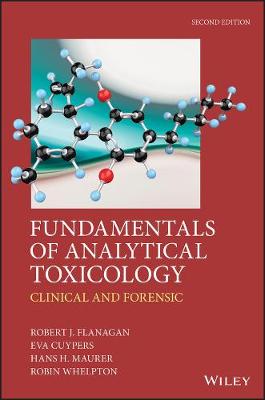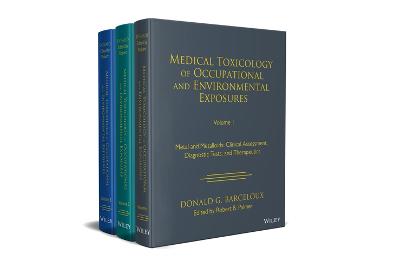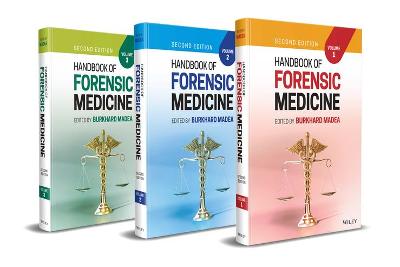Fundamentals of Analytical Toxicology
 -15%
portes grátis
-15%
portes grátis
Fundamentals of Analytical Toxicology
Clinical and Forensic
Flanagan, Robert J.; Maurer, Hans H.; Whelpton, Robin; Cuypers, Eva
John Wiley & Sons Inc
08/2020
656
Dura
Inglês
9781119122340
15 a 20 dias
1444
Descrição não disponível.
Preface xxiii
Health and Safety xxv
Nomenclature, Symbols, and Conventions xxvii
Uniform Resource Locators xxix
Amount Concentration and Mass Concentration xxxi
Acknowledgements xxxiii
List of Abbreviations xxxv
Section A The Basics 1
1 Analytical Toxicology: Overview 3
1.1 Introduction 3
1.2 Modern analytical toxicology 4
1.3 Provision of analytical toxicology services 10
1.4 Applications of analytical toxicology 15
1.5 Summary 21
References 21
2 Sample Collection, Transport, and Storage 23
2.1 Introduction 23
2.2 Clinical samples and sampling 23
2.3 Guidelines for sample collection for analytical toxicology 32
2.4 Sample transport, storage, and disposal 45
2.5 Common interferences 47
2.6 Summary 48
References 48
3 Basic Laboratory Operations 52
3.1 Introduction 52
3.2 Aspects of quantitative analysis 58
3.3 Use of internal standards 74
3.4 Method comparison 78
3.5 Non-parametric statistics 80
3.6 Quality control and quality assessment 84
3.7 Operational considerations 89
3.8 Summary 91
References 91
4 Aspects of Sample Preparation 94
4.1 Introduction 94
4.2 Modes of sample preparation 97
4.3 Plasma protein binding 112
4.4 Hydrolysis of conjugated metabolites 115
4.5 Extraction of drugs from tissues 117
4.6 Summary 117
References 118
5 Colour Tests, and Spectrophotometric and Luminescence Techniques 120
5.1 Introduction 120
5.2 Colour tests in toxicology 120
5.3 Colour tests for pharmaceuticals and illicit drugs 122
5.4 UV/Visible spectrophotometry 123
5.5 Fluorescence and phosphorescence 134
5.6 Chemiluminescence 138
5.7 Infrared and Raman spectroscopy 141
5.8 Summary 143
References 143
6 Immunoassays and Related Assays 145
6.1 Introduction 145
6.2 Basic principles of competitive binding assays 145
6.3 Heterogeneous immunoassays 151
6.4 Homogenous immunoassays 155
6.5 Microparticulate and turbidimetric immunoassays 159
6.6 Assay calibration, quality control, and quality assessment 160
6.7 Interferences and assay failures 162
6.8 Aptamer-based assays 163
6.9 Enzyme-based assays 163
6.10 Summary 165
References 166
Section B Separation Science 167
7 Separation Science: Theoretical Aspects 169
7.1 General introduction 169
7.2 Theoretical aspects of chromatography 170
7.3 Measurement of analyte retention 179
7.4 Summary 181
References 181
8 Planar Chromatography 182
8.1 Introduction 182
8.2 Qualitative thin-layer chromatography 183
8.3 Quantitative thin-layer chromatography 190
8.4 Summary 192
References 192
9 Gas Chromatography 193
9.1 Introduction 193
9.2 Instrumentation 194
9.3 Columns and column packings 203
9.4 Headspace and 'purge and trap' analysis 210
9.5 Formation of artefacts in gas chromatography 213
9.6 Derivatization for gas chromatography 213
9.7 Chiral separations 217
9.8 Summary 219
References 220
10 Liquid Chromatography 223
10.1 Introduction 223
10.2 General considerations 224
10.3 Detection in liquid chromatography 232
10.4 Columns and column packings 240
10.5 Modes of liquid chromatography 245
10.6 Chiral separations 250
10.7 Derivatives for liquid chromatography 255
10.8 Use of liquid chromatography in analytical toxicology 256
10.9 Summary 261
References 262
11 Supercritical Fluid Chromatography 264
11.1 Introduction 264
11.2 General considerations 267
11.3 Detection in supercritical fluid chromatography 269
11.4 Columns and column packings 269
11.5 Chiral separations 270
11.6 Toxicological and forensic applications 272
11.7 Summary 273
References 273
12 Capillary Electrophoretic Techniques 275
12.1 Introduction 275
12.2 Theoretical aspects 276
12.3 Sample injection in capillary electrophoresis 280
12.4 Detection in capillary electrophoresis 281
12.5 Other capillary electrokinetic modes 282
12.6 Capillary electrophoretic techniques in analytical toxicology 285
12.7 Summary 287
References 287
13 Mass Spectrometry 289
13.1 Introduction 289
13.2 Instrumentation 291
13.3 Gas chromatography-mass spectrometry 299
13.4 Liquid chromatography-mass spectrometry 304
13.5 Supercritical fluid chromatography-mass spectrometry 308
13.6 Capillary electrophoresis-mass spectrometry 309
13.7 Direct introduction mass spectrometry 310
13.8 Presentation of mass spectral data 315
13.9 Interpretation of mass spectra 317
13.10 Quantitative mass spectrometry 320
13.11 Mass spectrometry imaging 324
13.12 Summary 325
References 325
14 Ion Mobility Spectrometry 329
14.1 Introduction 329
14.2 Theoretical aspects 331
14.3 Types of ion mobility spectrometry 332
14.4 Resolving power 336
14.5 Interfacing ion mobility spectrometry 336
14.6 Applications of ion mobility spectrometry in analytical toxicology 339
14.7 Summary 342
References 342
Section C Essential Pharmacokinetics 345
15 Absorption, Distribution, Metabolism, and Excretion of Xenobiotics 347
15.1 Introduction 347
15.2 Movement of drugs and other xenobiotics around the body 347
15.3 Routes of administration 351
15.4 Distribution 355
15.5 Metabolism 357
15.6 Excretion 371
15.7 Pharmacogenetics and pharmacogenomics 373
15.8 Summary 376
References 377
16 Pharmacokinetics 379
16.1 Introduction 379
16.2 Fundamental concepts 379
16.3 Absorption and elimination 382
16.4 Drug accumulation 384
16.5 Sustained-release preparations 386
16.6 Non-linear pharmacokinetics 387
16.7 Multi-compartment models 390
16.8 Non-compartmental methods 392
16.9 Factors affecting pharmacokinetic parameters 393
16.10 Disease 396
16.11 Pharmacokinetics and the interpretation of results 397
16.12 Summary 402
References 402
Section D Analytical Toxicology 405
17 Toxicology Testing at the Point of Contact 407
17.1 Introduction 407
17.2 Use of point of contact testing 408
17.3 Toxicology testing at the point of contact 412
17.4 Interferences and adulterants 418
17.5 Quality assessment 419
17.6 Summary 419
References 419
18 Laboratory Testing for Substance Misuse 422
18.1 Introduction 422
18.2 Urine testing 425
18.3 Oral fluid testing 433
18.4 Blood testing 437
18.5 Hair testing 438
18.6 Breath testing 445
18.7 Sweat testing 446
18.8 Summary 446
References 447
19 General Analytical Toxicology 452
19.1 Introduction 452
19.2 Gas chromatography 453
19.3 Gas chromatography-mass spectrometry 456
19.4 Liquid chromatography 464
19.5 Liquid chromatography-mass spectrometry 464
19.6 Liquid chromatography-high resolution mass spectrometry 469
19.7 Summary 473
References 475
20 Therapeutic Drug Monitoring 479
20.1 Introduction 479
20.2 Sample collection 480
20.3 Sample types 481
20.4 Analytical methods 483
20.5 Factors affecting interpretation of results 485
20.6 Gazetteer 486
20.7 Summary 499
References 499
21 Trace Elements and Toxic Metals 505
21.1 Introduction 505
21.2 Sample collection and storage 505
21.3 Sample preparation 507
21.4 Atomic spectrometry 509
21.5 Colorimetry and fluorimetry 520
21.6 Electrochemical methods 521
21.7 Catalytic methods 523
21.8 Neutron activation analysis 523
21.9 Chromatographic methods 524
21.10 Quality assessment 525
21.11 Summary 525
References 525
22 Clinical Interpretation of Analytical Results 527
22.1 Introduction 527
22.2 Clinical toxicology 529
22.3 Forensic toxicology 533
22.4 Gazetteer 539
22.5 Sources of further information 574
22.6 Summary 576
References 576
Index 587
Health and Safety xxv
Nomenclature, Symbols, and Conventions xxvii
Uniform Resource Locators xxix
Amount Concentration and Mass Concentration xxxi
Acknowledgements xxxiii
List of Abbreviations xxxv
Section A The Basics 1
1 Analytical Toxicology: Overview 3
1.1 Introduction 3
1.2 Modern analytical toxicology 4
1.3 Provision of analytical toxicology services 10
1.4 Applications of analytical toxicology 15
1.5 Summary 21
References 21
2 Sample Collection, Transport, and Storage 23
2.1 Introduction 23
2.2 Clinical samples and sampling 23
2.3 Guidelines for sample collection for analytical toxicology 32
2.4 Sample transport, storage, and disposal 45
2.5 Common interferences 47
2.6 Summary 48
References 48
3 Basic Laboratory Operations 52
3.1 Introduction 52
3.2 Aspects of quantitative analysis 58
3.3 Use of internal standards 74
3.4 Method comparison 78
3.5 Non-parametric statistics 80
3.6 Quality control and quality assessment 84
3.7 Operational considerations 89
3.8 Summary 91
References 91
4 Aspects of Sample Preparation 94
4.1 Introduction 94
4.2 Modes of sample preparation 97
4.3 Plasma protein binding 112
4.4 Hydrolysis of conjugated metabolites 115
4.5 Extraction of drugs from tissues 117
4.6 Summary 117
References 118
5 Colour Tests, and Spectrophotometric and Luminescence Techniques 120
5.1 Introduction 120
5.2 Colour tests in toxicology 120
5.3 Colour tests for pharmaceuticals and illicit drugs 122
5.4 UV/Visible spectrophotometry 123
5.5 Fluorescence and phosphorescence 134
5.6 Chemiluminescence 138
5.7 Infrared and Raman spectroscopy 141
5.8 Summary 143
References 143
6 Immunoassays and Related Assays 145
6.1 Introduction 145
6.2 Basic principles of competitive binding assays 145
6.3 Heterogeneous immunoassays 151
6.4 Homogenous immunoassays 155
6.5 Microparticulate and turbidimetric immunoassays 159
6.6 Assay calibration, quality control, and quality assessment 160
6.7 Interferences and assay failures 162
6.8 Aptamer-based assays 163
6.9 Enzyme-based assays 163
6.10 Summary 165
References 166
Section B Separation Science 167
7 Separation Science: Theoretical Aspects 169
7.1 General introduction 169
7.2 Theoretical aspects of chromatography 170
7.3 Measurement of analyte retention 179
7.4 Summary 181
References 181
8 Planar Chromatography 182
8.1 Introduction 182
8.2 Qualitative thin-layer chromatography 183
8.3 Quantitative thin-layer chromatography 190
8.4 Summary 192
References 192
9 Gas Chromatography 193
9.1 Introduction 193
9.2 Instrumentation 194
9.3 Columns and column packings 203
9.4 Headspace and 'purge and trap' analysis 210
9.5 Formation of artefacts in gas chromatography 213
9.6 Derivatization for gas chromatography 213
9.7 Chiral separations 217
9.8 Summary 219
References 220
10 Liquid Chromatography 223
10.1 Introduction 223
10.2 General considerations 224
10.3 Detection in liquid chromatography 232
10.4 Columns and column packings 240
10.5 Modes of liquid chromatography 245
10.6 Chiral separations 250
10.7 Derivatives for liquid chromatography 255
10.8 Use of liquid chromatography in analytical toxicology 256
10.9 Summary 261
References 262
11 Supercritical Fluid Chromatography 264
11.1 Introduction 264
11.2 General considerations 267
11.3 Detection in supercritical fluid chromatography 269
11.4 Columns and column packings 269
11.5 Chiral separations 270
11.6 Toxicological and forensic applications 272
11.7 Summary 273
References 273
12 Capillary Electrophoretic Techniques 275
12.1 Introduction 275
12.2 Theoretical aspects 276
12.3 Sample injection in capillary electrophoresis 280
12.4 Detection in capillary electrophoresis 281
12.5 Other capillary electrokinetic modes 282
12.6 Capillary electrophoretic techniques in analytical toxicology 285
12.7 Summary 287
References 287
13 Mass Spectrometry 289
13.1 Introduction 289
13.2 Instrumentation 291
13.3 Gas chromatography-mass spectrometry 299
13.4 Liquid chromatography-mass spectrometry 304
13.5 Supercritical fluid chromatography-mass spectrometry 308
13.6 Capillary electrophoresis-mass spectrometry 309
13.7 Direct introduction mass spectrometry 310
13.8 Presentation of mass spectral data 315
13.9 Interpretation of mass spectra 317
13.10 Quantitative mass spectrometry 320
13.11 Mass spectrometry imaging 324
13.12 Summary 325
References 325
14 Ion Mobility Spectrometry 329
14.1 Introduction 329
14.2 Theoretical aspects 331
14.3 Types of ion mobility spectrometry 332
14.4 Resolving power 336
14.5 Interfacing ion mobility spectrometry 336
14.6 Applications of ion mobility spectrometry in analytical toxicology 339
14.7 Summary 342
References 342
Section C Essential Pharmacokinetics 345
15 Absorption, Distribution, Metabolism, and Excretion of Xenobiotics 347
15.1 Introduction 347
15.2 Movement of drugs and other xenobiotics around the body 347
15.3 Routes of administration 351
15.4 Distribution 355
15.5 Metabolism 357
15.6 Excretion 371
15.7 Pharmacogenetics and pharmacogenomics 373
15.8 Summary 376
References 377
16 Pharmacokinetics 379
16.1 Introduction 379
16.2 Fundamental concepts 379
16.3 Absorption and elimination 382
16.4 Drug accumulation 384
16.5 Sustained-release preparations 386
16.6 Non-linear pharmacokinetics 387
16.7 Multi-compartment models 390
16.8 Non-compartmental methods 392
16.9 Factors affecting pharmacokinetic parameters 393
16.10 Disease 396
16.11 Pharmacokinetics and the interpretation of results 397
16.12 Summary 402
References 402
Section D Analytical Toxicology 405
17 Toxicology Testing at the Point of Contact 407
17.1 Introduction 407
17.2 Use of point of contact testing 408
17.3 Toxicology testing at the point of contact 412
17.4 Interferences and adulterants 418
17.5 Quality assessment 419
17.6 Summary 419
References 419
18 Laboratory Testing for Substance Misuse 422
18.1 Introduction 422
18.2 Urine testing 425
18.3 Oral fluid testing 433
18.4 Blood testing 437
18.5 Hair testing 438
18.6 Breath testing 445
18.7 Sweat testing 446
18.8 Summary 446
References 447
19 General Analytical Toxicology 452
19.1 Introduction 452
19.2 Gas chromatography 453
19.3 Gas chromatography-mass spectrometry 456
19.4 Liquid chromatography 464
19.5 Liquid chromatography-mass spectrometry 464
19.6 Liquid chromatography-high resolution mass spectrometry 469
19.7 Summary 473
References 475
20 Therapeutic Drug Monitoring 479
20.1 Introduction 479
20.2 Sample collection 480
20.3 Sample types 481
20.4 Analytical methods 483
20.5 Factors affecting interpretation of results 485
20.6 Gazetteer 486
20.7 Summary 499
References 499
21 Trace Elements and Toxic Metals 505
21.1 Introduction 505
21.2 Sample collection and storage 505
21.3 Sample preparation 507
21.4 Atomic spectrometry 509
21.5 Colorimetry and fluorimetry 520
21.6 Electrochemical methods 521
21.7 Catalytic methods 523
21.8 Neutron activation analysis 523
21.9 Chromatographic methods 524
21.10 Quality assessment 525
21.11 Summary 525
References 525
22 Clinical Interpretation of Analytical Results 527
22.1 Introduction 527
22.2 Clinical toxicology 529
22.3 Forensic toxicology 533
22.4 Gazetteer 539
22.5 Sources of further information 574
22.6 Summary 576
References 576
Index 587
Este título pertence ao(s) assunto(s) indicados(s). Para ver outros títulos clique no assunto desejado.
analytical toxicology; analytical toxicology introduction; analytical toxicology textbook; separation science; pharmacokinetics; gas chromatography; liquid chromatography; gas-liquid-chromatography; mass spectrometry; clinical toxicology; substance misuse testing; therapeutic drug monitoring; trace elements/toxic metals analysis
Preface xxiii
Health and Safety xxv
Nomenclature, Symbols, and Conventions xxvii
Uniform Resource Locators xxix
Amount Concentration and Mass Concentration xxxi
Acknowledgements xxxiii
List of Abbreviations xxxv
Section A The Basics 1
1 Analytical Toxicology: Overview 3
1.1 Introduction 3
1.2 Modern analytical toxicology 4
1.3 Provision of analytical toxicology services 10
1.4 Applications of analytical toxicology 15
1.5 Summary 21
References 21
2 Sample Collection, Transport, and Storage 23
2.1 Introduction 23
2.2 Clinical samples and sampling 23
2.3 Guidelines for sample collection for analytical toxicology 32
2.4 Sample transport, storage, and disposal 45
2.5 Common interferences 47
2.6 Summary 48
References 48
3 Basic Laboratory Operations 52
3.1 Introduction 52
3.2 Aspects of quantitative analysis 58
3.3 Use of internal standards 74
3.4 Method comparison 78
3.5 Non-parametric statistics 80
3.6 Quality control and quality assessment 84
3.7 Operational considerations 89
3.8 Summary 91
References 91
4 Aspects of Sample Preparation 94
4.1 Introduction 94
4.2 Modes of sample preparation 97
4.3 Plasma protein binding 112
4.4 Hydrolysis of conjugated metabolites 115
4.5 Extraction of drugs from tissues 117
4.6 Summary 117
References 118
5 Colour Tests, and Spectrophotometric and Luminescence Techniques 120
5.1 Introduction 120
5.2 Colour tests in toxicology 120
5.3 Colour tests for pharmaceuticals and illicit drugs 122
5.4 UV/Visible spectrophotometry 123
5.5 Fluorescence and phosphorescence 134
5.6 Chemiluminescence 138
5.7 Infrared and Raman spectroscopy 141
5.8 Summary 143
References 143
6 Immunoassays and Related Assays 145
6.1 Introduction 145
6.2 Basic principles of competitive binding assays 145
6.3 Heterogeneous immunoassays 151
6.4 Homogenous immunoassays 155
6.5 Microparticulate and turbidimetric immunoassays 159
6.6 Assay calibration, quality control, and quality assessment 160
6.7 Interferences and assay failures 162
6.8 Aptamer-based assays 163
6.9 Enzyme-based assays 163
6.10 Summary 165
References 166
Section B Separation Science 167
7 Separation Science: Theoretical Aspects 169
7.1 General introduction 169
7.2 Theoretical aspects of chromatography 170
7.3 Measurement of analyte retention 179
7.4 Summary 181
References 181
8 Planar Chromatography 182
8.1 Introduction 182
8.2 Qualitative thin-layer chromatography 183
8.3 Quantitative thin-layer chromatography 190
8.4 Summary 192
References 192
9 Gas Chromatography 193
9.1 Introduction 193
9.2 Instrumentation 194
9.3 Columns and column packings 203
9.4 Headspace and 'purge and trap' analysis 210
9.5 Formation of artefacts in gas chromatography 213
9.6 Derivatization for gas chromatography 213
9.7 Chiral separations 217
9.8 Summary 219
References 220
10 Liquid Chromatography 223
10.1 Introduction 223
10.2 General considerations 224
10.3 Detection in liquid chromatography 232
10.4 Columns and column packings 240
10.5 Modes of liquid chromatography 245
10.6 Chiral separations 250
10.7 Derivatives for liquid chromatography 255
10.8 Use of liquid chromatography in analytical toxicology 256
10.9 Summary 261
References 262
11 Supercritical Fluid Chromatography 264
11.1 Introduction 264
11.2 General considerations 267
11.3 Detection in supercritical fluid chromatography 269
11.4 Columns and column packings 269
11.5 Chiral separations 270
11.6 Toxicological and forensic applications 272
11.7 Summary 273
References 273
12 Capillary Electrophoretic Techniques 275
12.1 Introduction 275
12.2 Theoretical aspects 276
12.3 Sample injection in capillary electrophoresis 280
12.4 Detection in capillary electrophoresis 281
12.5 Other capillary electrokinetic modes 282
12.6 Capillary electrophoretic techniques in analytical toxicology 285
12.7 Summary 287
References 287
13 Mass Spectrometry 289
13.1 Introduction 289
13.2 Instrumentation 291
13.3 Gas chromatography-mass spectrometry 299
13.4 Liquid chromatography-mass spectrometry 304
13.5 Supercritical fluid chromatography-mass spectrometry 308
13.6 Capillary electrophoresis-mass spectrometry 309
13.7 Direct introduction mass spectrometry 310
13.8 Presentation of mass spectral data 315
13.9 Interpretation of mass spectra 317
13.10 Quantitative mass spectrometry 320
13.11 Mass spectrometry imaging 324
13.12 Summary 325
References 325
14 Ion Mobility Spectrometry 329
14.1 Introduction 329
14.2 Theoretical aspects 331
14.3 Types of ion mobility spectrometry 332
14.4 Resolving power 336
14.5 Interfacing ion mobility spectrometry 336
14.6 Applications of ion mobility spectrometry in analytical toxicology 339
14.7 Summary 342
References 342
Section C Essential Pharmacokinetics 345
15 Absorption, Distribution, Metabolism, and Excretion of Xenobiotics 347
15.1 Introduction 347
15.2 Movement of drugs and other xenobiotics around the body 347
15.3 Routes of administration 351
15.4 Distribution 355
15.5 Metabolism 357
15.6 Excretion 371
15.7 Pharmacogenetics and pharmacogenomics 373
15.8 Summary 376
References 377
16 Pharmacokinetics 379
16.1 Introduction 379
16.2 Fundamental concepts 379
16.3 Absorption and elimination 382
16.4 Drug accumulation 384
16.5 Sustained-release preparations 386
16.6 Non-linear pharmacokinetics 387
16.7 Multi-compartment models 390
16.8 Non-compartmental methods 392
16.9 Factors affecting pharmacokinetic parameters 393
16.10 Disease 396
16.11 Pharmacokinetics and the interpretation of results 397
16.12 Summary 402
References 402
Section D Analytical Toxicology 405
17 Toxicology Testing at the Point of Contact 407
17.1 Introduction 407
17.2 Use of point of contact testing 408
17.3 Toxicology testing at the point of contact 412
17.4 Interferences and adulterants 418
17.5 Quality assessment 419
17.6 Summary 419
References 419
18 Laboratory Testing for Substance Misuse 422
18.1 Introduction 422
18.2 Urine testing 425
18.3 Oral fluid testing 433
18.4 Blood testing 437
18.5 Hair testing 438
18.6 Breath testing 445
18.7 Sweat testing 446
18.8 Summary 446
References 447
19 General Analytical Toxicology 452
19.1 Introduction 452
19.2 Gas chromatography 453
19.3 Gas chromatography-mass spectrometry 456
19.4 Liquid chromatography 464
19.5 Liquid chromatography-mass spectrometry 464
19.6 Liquid chromatography-high resolution mass spectrometry 469
19.7 Summary 473
References 475
20 Therapeutic Drug Monitoring 479
20.1 Introduction 479
20.2 Sample collection 480
20.3 Sample types 481
20.4 Analytical methods 483
20.5 Factors affecting interpretation of results 485
20.6 Gazetteer 486
20.7 Summary 499
References 499
21 Trace Elements and Toxic Metals 505
21.1 Introduction 505
21.2 Sample collection and storage 505
21.3 Sample preparation 507
21.4 Atomic spectrometry 509
21.5 Colorimetry and fluorimetry 520
21.6 Electrochemical methods 521
21.7 Catalytic methods 523
21.8 Neutron activation analysis 523
21.9 Chromatographic methods 524
21.10 Quality assessment 525
21.11 Summary 525
References 525
22 Clinical Interpretation of Analytical Results 527
22.1 Introduction 527
22.2 Clinical toxicology 529
22.3 Forensic toxicology 533
22.4 Gazetteer 539
22.5 Sources of further information 574
22.6 Summary 576
References 576
Index 587
Health and Safety xxv
Nomenclature, Symbols, and Conventions xxvii
Uniform Resource Locators xxix
Amount Concentration and Mass Concentration xxxi
Acknowledgements xxxiii
List of Abbreviations xxxv
Section A The Basics 1
1 Analytical Toxicology: Overview 3
1.1 Introduction 3
1.2 Modern analytical toxicology 4
1.3 Provision of analytical toxicology services 10
1.4 Applications of analytical toxicology 15
1.5 Summary 21
References 21
2 Sample Collection, Transport, and Storage 23
2.1 Introduction 23
2.2 Clinical samples and sampling 23
2.3 Guidelines for sample collection for analytical toxicology 32
2.4 Sample transport, storage, and disposal 45
2.5 Common interferences 47
2.6 Summary 48
References 48
3 Basic Laboratory Operations 52
3.1 Introduction 52
3.2 Aspects of quantitative analysis 58
3.3 Use of internal standards 74
3.4 Method comparison 78
3.5 Non-parametric statistics 80
3.6 Quality control and quality assessment 84
3.7 Operational considerations 89
3.8 Summary 91
References 91
4 Aspects of Sample Preparation 94
4.1 Introduction 94
4.2 Modes of sample preparation 97
4.3 Plasma protein binding 112
4.4 Hydrolysis of conjugated metabolites 115
4.5 Extraction of drugs from tissues 117
4.6 Summary 117
References 118
5 Colour Tests, and Spectrophotometric and Luminescence Techniques 120
5.1 Introduction 120
5.2 Colour tests in toxicology 120
5.3 Colour tests for pharmaceuticals and illicit drugs 122
5.4 UV/Visible spectrophotometry 123
5.5 Fluorescence and phosphorescence 134
5.6 Chemiluminescence 138
5.7 Infrared and Raman spectroscopy 141
5.8 Summary 143
References 143
6 Immunoassays and Related Assays 145
6.1 Introduction 145
6.2 Basic principles of competitive binding assays 145
6.3 Heterogeneous immunoassays 151
6.4 Homogenous immunoassays 155
6.5 Microparticulate and turbidimetric immunoassays 159
6.6 Assay calibration, quality control, and quality assessment 160
6.7 Interferences and assay failures 162
6.8 Aptamer-based assays 163
6.9 Enzyme-based assays 163
6.10 Summary 165
References 166
Section B Separation Science 167
7 Separation Science: Theoretical Aspects 169
7.1 General introduction 169
7.2 Theoretical aspects of chromatography 170
7.3 Measurement of analyte retention 179
7.4 Summary 181
References 181
8 Planar Chromatography 182
8.1 Introduction 182
8.2 Qualitative thin-layer chromatography 183
8.3 Quantitative thin-layer chromatography 190
8.4 Summary 192
References 192
9 Gas Chromatography 193
9.1 Introduction 193
9.2 Instrumentation 194
9.3 Columns and column packings 203
9.4 Headspace and 'purge and trap' analysis 210
9.5 Formation of artefacts in gas chromatography 213
9.6 Derivatization for gas chromatography 213
9.7 Chiral separations 217
9.8 Summary 219
References 220
10 Liquid Chromatography 223
10.1 Introduction 223
10.2 General considerations 224
10.3 Detection in liquid chromatography 232
10.4 Columns and column packings 240
10.5 Modes of liquid chromatography 245
10.6 Chiral separations 250
10.7 Derivatives for liquid chromatography 255
10.8 Use of liquid chromatography in analytical toxicology 256
10.9 Summary 261
References 262
11 Supercritical Fluid Chromatography 264
11.1 Introduction 264
11.2 General considerations 267
11.3 Detection in supercritical fluid chromatography 269
11.4 Columns and column packings 269
11.5 Chiral separations 270
11.6 Toxicological and forensic applications 272
11.7 Summary 273
References 273
12 Capillary Electrophoretic Techniques 275
12.1 Introduction 275
12.2 Theoretical aspects 276
12.3 Sample injection in capillary electrophoresis 280
12.4 Detection in capillary electrophoresis 281
12.5 Other capillary electrokinetic modes 282
12.6 Capillary electrophoretic techniques in analytical toxicology 285
12.7 Summary 287
References 287
13 Mass Spectrometry 289
13.1 Introduction 289
13.2 Instrumentation 291
13.3 Gas chromatography-mass spectrometry 299
13.4 Liquid chromatography-mass spectrometry 304
13.5 Supercritical fluid chromatography-mass spectrometry 308
13.6 Capillary electrophoresis-mass spectrometry 309
13.7 Direct introduction mass spectrometry 310
13.8 Presentation of mass spectral data 315
13.9 Interpretation of mass spectra 317
13.10 Quantitative mass spectrometry 320
13.11 Mass spectrometry imaging 324
13.12 Summary 325
References 325
14 Ion Mobility Spectrometry 329
14.1 Introduction 329
14.2 Theoretical aspects 331
14.3 Types of ion mobility spectrometry 332
14.4 Resolving power 336
14.5 Interfacing ion mobility spectrometry 336
14.6 Applications of ion mobility spectrometry in analytical toxicology 339
14.7 Summary 342
References 342
Section C Essential Pharmacokinetics 345
15 Absorption, Distribution, Metabolism, and Excretion of Xenobiotics 347
15.1 Introduction 347
15.2 Movement of drugs and other xenobiotics around the body 347
15.3 Routes of administration 351
15.4 Distribution 355
15.5 Metabolism 357
15.6 Excretion 371
15.7 Pharmacogenetics and pharmacogenomics 373
15.8 Summary 376
References 377
16 Pharmacokinetics 379
16.1 Introduction 379
16.2 Fundamental concepts 379
16.3 Absorption and elimination 382
16.4 Drug accumulation 384
16.5 Sustained-release preparations 386
16.6 Non-linear pharmacokinetics 387
16.7 Multi-compartment models 390
16.8 Non-compartmental methods 392
16.9 Factors affecting pharmacokinetic parameters 393
16.10 Disease 396
16.11 Pharmacokinetics and the interpretation of results 397
16.12 Summary 402
References 402
Section D Analytical Toxicology 405
17 Toxicology Testing at the Point of Contact 407
17.1 Introduction 407
17.2 Use of point of contact testing 408
17.3 Toxicology testing at the point of contact 412
17.4 Interferences and adulterants 418
17.5 Quality assessment 419
17.6 Summary 419
References 419
18 Laboratory Testing for Substance Misuse 422
18.1 Introduction 422
18.2 Urine testing 425
18.3 Oral fluid testing 433
18.4 Blood testing 437
18.5 Hair testing 438
18.6 Breath testing 445
18.7 Sweat testing 446
18.8 Summary 446
References 447
19 General Analytical Toxicology 452
19.1 Introduction 452
19.2 Gas chromatography 453
19.3 Gas chromatography-mass spectrometry 456
19.4 Liquid chromatography 464
19.5 Liquid chromatography-mass spectrometry 464
19.6 Liquid chromatography-high resolution mass spectrometry 469
19.7 Summary 473
References 475
20 Therapeutic Drug Monitoring 479
20.1 Introduction 479
20.2 Sample collection 480
20.3 Sample types 481
20.4 Analytical methods 483
20.5 Factors affecting interpretation of results 485
20.6 Gazetteer 486
20.7 Summary 499
References 499
21 Trace Elements and Toxic Metals 505
21.1 Introduction 505
21.2 Sample collection and storage 505
21.3 Sample preparation 507
21.4 Atomic spectrometry 509
21.5 Colorimetry and fluorimetry 520
21.6 Electrochemical methods 521
21.7 Catalytic methods 523
21.8 Neutron activation analysis 523
21.9 Chromatographic methods 524
21.10 Quality assessment 525
21.11 Summary 525
References 525
22 Clinical Interpretation of Analytical Results 527
22.1 Introduction 527
22.2 Clinical toxicology 529
22.3 Forensic toxicology 533
22.4 Gazetteer 539
22.5 Sources of further information 574
22.6 Summary 576
References 576
Index 587
Este título pertence ao(s) assunto(s) indicados(s). Para ver outros títulos clique no assunto desejado.
analytical toxicology; analytical toxicology introduction; analytical toxicology textbook; separation science; pharmacokinetics; gas chromatography; liquid chromatography; gas-liquid-chromatography; mass spectrometry; clinical toxicology; substance misuse testing; therapeutic drug monitoring; trace elements/toxic metals analysis







